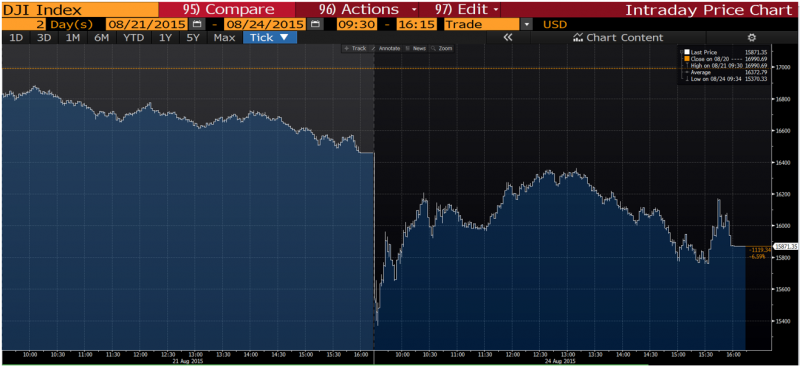Most Mondays we all just want to ease into the week, uneventfully. And for all the angst (and internet memes), they usually aren’t that bad. Yeah, there’s a lot of work to be done, maybe requiring a deep breath or two and some focus, but before long we get into the rhythm of the week (helped by the promise of another weekend).
On one particular Monday, a large overnight selloff in the Chinese equity market had many market observers anticipating a less than smooth start to August 24, 2015. And they weren’t wrong. Shortly after the opening bell, the Dow Jones Industrial Average Index tumbled 6% and the S&P 500 Index fell 5%. Many stocks dropped more than 20%. In short order, Wall Street’s fear gauge, the VIX, spiked to an intraday high of 53—its highest recorded level outside of the 2008-09 financial crisis.1
Below is how the Dow Jones Industrial Average reacted from August 21st through August 24th. Note the precipitous decline on market open August 24th.

Source: Bloomberg. Index represented by Dow Jones Industrial Average Index. Data from 8/21/15 to 8/24/15.
If it hadn’t already, the extraordinary nature of the situation hit home when the New York Stock Exchange (NYSE) invoked the rarely then used Rule 48. Designating an extreme market volatility condition, Rule 48 suspended the requirement that stock prices be announced before trading commenced. The idea was to speed up the market’s open and mitigate some of the volatility. But complicating matters was that the stock exchange volatility rules created after the 2010 Flash Crash went into effect as well. As a result, about 100 stocks and 300 exchange-traded funds were temporarily halted, some repeatedly.2
Walking a Tightrope
Volatility rules don’t discriminate. Securities of all types were affected on that Monday. But that day’s trading dynamics were particularly illustrative of how ETFs operate.
Under normal market conditions, when an ETF’s price diverges from its Net Asset Value (NAV), Authorized Participants, typically large financial institutions, act as arbitrageurs. Usually, this process helps ETF prices track their underlying indexes.
However, on that August 24, 2015, Authorized Participants were largely flying blind due to dozens of halted stocks and limited price information. Without accurate reads on the prices of the underlying basket of securities, many ETF market makers widened their spreads—the difference between their buying and selling price—or withdrew bids entirely. The result was an irregularly thin market combined with a backlog of orders piling up during the halts, which caused some ETFs to trade more than 40% away from their NAVs, many of which were down just a fraction of that amount.2
ETF Arbitrage Explained
Exchange-traded funds are designed to track their indexes and underlying baskets, based on Authorized Participants profiting from an ETF’s price becoming unmoored from the price of its basket of securities. Authorized Participants exchange the underlying basket of securities for shares of the ETF (i.e., the “creation process”), or shares of the ETF for the underlying basket (i.e., the “redemption process”), which helps to keep the ETF’s price tracking the value of the underlying index.
Explained another way, the arbitrage mechanism is a version of buy low, sell high. If an ETF sells for more than the true value of the underlying securities, an Authorized Participant could sell (high) the overvalued ETF and buy (low) the underlying basket. Thereafter, the Authorized Participant would exchange those securities for the ETF (a “creation”) to cover the short sale of the ETF and pocket the price difference.
It’s the reverse when an ETF is undervalued relative to the underlying basket. An Authorized Participant would sell (high) the various securities that comprise the basket short, buy (low) shares of the ETF, and exchange them for the underlying securities (a “redemption”) to cover the short. The Authorized Participant would pocket the difference.
The catch? The process typically requires (with some exceptions) that Authorized Participants know the price of the underlying basket.
How Times have Changed
About six months after that frenetic Monday opening, the NYSE took several steps to prevent another one. It started by eliminating Rule 48, which many considered obsolete. More importantly, the NYSE improved its dissemination of opening imbalance information by offering greater transparency to the market, improving opening procedures, and increasing the market’s resiliency during times of stress.
Thereafter, the NYSE, along with Nasdaq and Bats, enhanced their limit-up/limit-down (LULD) rules to better handle openings across all the exchanges when a security hits a “circuit breaker”. In addition, the exchanges have now added Amendment 10 to LULD, which uses the prior trading session’s close price for the reference on the next session’s LULD bands. Before that, the midpoint between the opening bid/ask prices was used, which could have thrown off trading band numbers.3 The new rules eliminate the time periods when securities could trade without LULD bands in place, as well as standardize automated re-openings after a trading halt and erroneous execution rules when LULD bands are in effect.
Put to the Test
Later that week of August 24, 2015, the market stabilized, liquidity returned to more normalized levels, and the fears that sent the VIX soaring eased. ETFs, being pass-through vehicles, were not the culprits on that Monday, but the experience demonstrated that we needed better exchange rules to ensure liquidity and orderly halts/reopens during periods of extreme volatility.
Fortunately, the market’s formal and informal responses to extraordinary events seem to have improved since then with refined volatility-induced rules and better communication among market participants. And this work to enhance opening procedures when the market gets manic has likely paid dividends already—there was little ordinary about the Brexit vote or the US presidential election, yet smooth market openings followed those events, despite rather dramatic spikes in volume and volatility.
 Global X ETF Model Portfolio Team
Global X ETF Model Portfolio Team